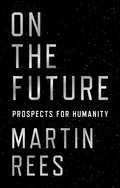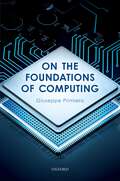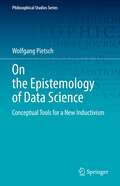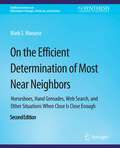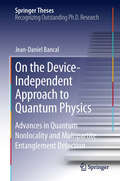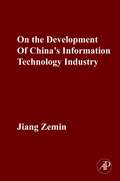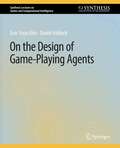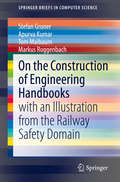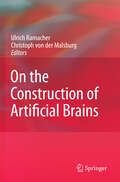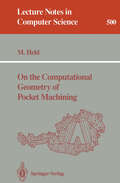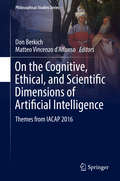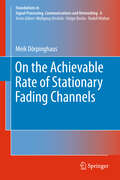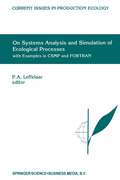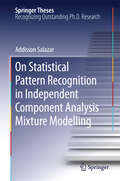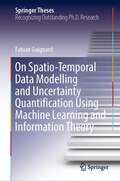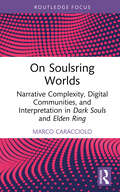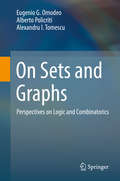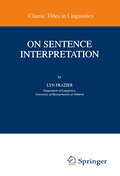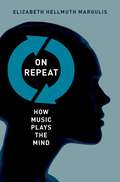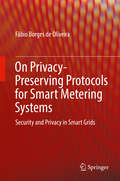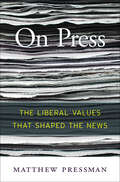- Table View
- List View
On the Future: Prospects for Humanity
by Martin ReesA provocative and inspiring look at the future of humanity and science from world-renowned scientist and bestselling author Martin ReesHumanity has reached a critical moment. Our world is unsettled and rapidly changing, and we face existential risks over the next century. Various outcomes—good and bad—are possible. Yet our approach to the future is characterized by short-term thinking, polarizing debates, alarmist rhetoric, and pessimism. In this short, exhilarating book, renowned scientist and bestselling author Martin Rees argues that humanity’s prospects depend on our taking a very different approach to planning for tomorrow.The future of humanity is bound to the future of science and hinges on how successfully we harness technological advances to address our challenges. If we are to use science to solve our problems while avoiding its dystopian risks, we must think rationally, globally, collectively, and optimistically about the long term. Advances in biotechnology, cybertechnology, robotics, and artificial intelligence—if pursued and applied wisely—could empower us to boost the developing and developed world and overcome the threats humanity faces on Earth, from climate change to nuclear war. At the same time, further advances in space science will allow humans to explore the solar system and beyond with robots and AI. But there is no “Plan B” for Earth—no viable alternative within reach if we do not care for our home planet.Rich with fascinating insights into cutting-edge science and technology, this accessible book will captivate anyone who wants to understand the critical issues that will define the future of humanity on Earth and beyond.
On the Future: Prospects for Humanity
by Martin ReesA provocative and inspiring look at the future of humanity and science from world-renowned scientist and bestselling author Martin ReesHumanity has reached a critical moment. Our world is unsettled and rapidly changing, and we face existential risks over the next century. Various outcomes—good and bad—are possible. Yet our approach to the future is characterized by short-term thinking, polarizing debates, alarmist rhetoric, and pessimism. In this short, exhilarating book, renowned scientist and bestselling author Martin Rees argues that humanity’s prospects depend on our taking a very different approach to planning for tomorrow.The future of humanity is bound to the future of science and hinges on how successfully we harness technological advances to address our challenges. If we are to use science to solve our problems while avoiding its dystopian risks, we must think rationally, globally, collectively, and optimistically about the long term. Advances in biotechnology, cybertechnology, robotics, and artificial intelligence—if pursued and applied wisely—could empower us to boost the developing and developed world and overcome the threats humanity faces on Earth, from climate change to nuclear war. At the same time, further advances in space science will allow humans to explore the solar system and beyond with robots and AI. But there is no “Plan B” for Earth—no viable alternative within reach if we do not care for our home planet.Rich with fascinating insights into cutting-edge science and technology, this accessible book will captivate anyone who wants to understand the critical issues that will define the future of humanity on Earth and beyond.
On the Future: Prospects for Humanity
by Martin ReesA provocative and inspiring look at the future of humanity and science from world-renowned scientist and bestselling author Martin ReesHumanity has reached a critical moment. Our world is unsettled and rapidly changing, and we face existential risks over the next century. Various outcomes—good and bad—are possible. Yet our approach to the future is characterized by short-term thinking, polarizing debates, alarmist rhetoric, and pessimism. In this short, exhilarating book, renowned scientist and bestselling author Martin Rees argues that humanity’s prospects depend on our taking a very different approach to planning for tomorrow.The future of humanity is bound to the future of science and hinges on how successfully we harness technological advances to address our challenges. If we are to use science to solve our problems while avoiding its dystopian risks, we must think rationally, globally, collectively, and optimistically about the long term. Advances in biotechnology, cybertechnology, robotics, and artificial intelligence—if pursued and applied wisely—could empower us to boost the developing and developed world and overcome the threats humanity faces on Earth, from climate change to nuclear war. At the same time, further advances in space science will allow humans to explore the solar system and beyond with robots and AI. But there is no “Plan B” for Earth—no viable alternative within reach if we do not care for our home planet.Rich with fascinating insights into cutting-edge science and technology, this accessible book will captivate anyone who wants to understand the critical issues that will define the future of humanity on Earth and beyond.
On the Foundations of Computing
by Giuseppe PrimieroComputing, today more than ever before, is a multi-faceted discipline which collates several methodologies, areas of interest, and approaches: mathematics, engineering, programming, and applications. Given its enormous impact on everyday life, it is essential that its debated origins are understood, and that its different foundations are explained. On the Foundations of Computing offers a comprehensive and critical overview of the birth and evolution of computing, and it presents some of the most important technical results and philosophical problems of the discipline, combining both historical and systematic analyses. The debates this text surveys are among the latest and most urgent ones: the crisis of foundations in mathematics and the birth of the decision problem, the nature of algorithms, the debates on computational artefacts and malfunctioning, and the analysis of computational experiments. By covering these topics, On the Foundations of Computing provides a much-needed resource to contextualize these foundational issues. For practitioners, researchers, and students alike, a historical and philosophical approach such as what this volume offers becomes essential to understand the past of the discipline and to figure out the challenges of its future.
On the Epistemology of Data Science: Conceptual Tools for a New Inductivism (Philosophical Studies Series #148)
by Wolfgang PietschThis book addresses controversies concerning the epistemological foundations of data science: Is it a genuine science? Or is data science merely some inferior practice that can at best contribute to the scientific enterprise, but cannot stand on its own? The author proposes a coherent conceptual framework with which these questions can be rigorously addressed. Readers will discover a defense of inductivism and consideration of the arguments against it: an epistemology of data science more or less by definition has to be inductivist, given that data science starts with the data. As an alternative to enumerative approaches, the author endorses Federica Russo’s recent call for a variational rationale in inductive methodology. Chapters then address some of the key concepts of an inductivist methodology including causation, probability and analogy, before outlining an inductivist framework. The inductivist framework is shown to be adequate and useful for an analysis of the epistemological foundations of data science. The author points out that many aspects of the variational rationale are present in algorithms commonly used in data science. Introductions to algorithms and brief case studies of successful data science such as machine translation are included. Data science is located with reference to several crucial distinctions regarding different kinds of scientific practices, including between exploratory and theory-driven experimentation, and between phenomenological and theoretical science. Computer scientists, philosophers and data scientists of various disciplines will find this philosophical perspective and conceptual framework of great interest, especially as a starting point for further in-depth analysis of algorithms used in data science.
On the Efficient Determination of Most Near Neighbors: Horseshoes, Hand Grenades, Web Search and Other Situations When Close Is Close Enough, Second Edition (Synthesis Lectures on Information Concepts, Retrieval, and Services)
by Mark S. ManasseThe time-worn aphorism "close only counts in horseshoes and hand grenades" is clearly inadequate. Close also counts in golf, shuffleboard, archery, darts, curling, and other games of accuracy in which hitting the precise center of the target isn't to be expected every time, or in which we can expect to be driven from the target by skilled opponents. This book is not devoted to sports discussions, but to efficient algorithms for determining pairs of closely related web pages—and a few other situations in which we have found that inexact matching is good enough — where proximity suffices. We will not, however, attempt to be comprehensive in the investigation of probabilistic algorithms, approximation algorithms, or even techniques for organizing the discovery of nearest neighbors. We are more concerned with finding nearby neighbors; if they are not particularly close by, we are not particularly interested. In thinking of when approximation is sufficient, remember the oft-told joke about two campers sitting around after dinner. They hear noises coming towards them. One of them reaches for a pair of running shoes, and starts to don them. The second then notes that even with running shoes, they cannot hope to outrun a bear, to which the first notes that most likely the bear will be satiated after catching the slower of them. We seek problems in which we don't need to be faster than the bear, just faster than the others fleeing the bear.
On the Device-Independent Approach to Quantum Physics: Advances in Quantum Nonlocality and Multipartite Entanglement Detection (Springer Theses)
by Jean-Daniel BancalQuantum physics started in the 1920's with wave mechanics and the wave-particle duality. However, the last 20 years have seen a second quantum revolution, centered around non-locality and quantum correlations between measurement outcomes. The associated key property, entanglement, is recognized today as the signature of quantumness. This second revolution opened the possibility of studying quantum correlations without any assumption on the internal functioning of the measurement apparata, the so-called Device-Independent Approach to Quantum Physics. This thesis explores this new approach using the powerful geometrical tool of polytopes. Emphasis is placed on the study of non-locality in the case of three or more parties, where it is shown that a whole new variety of phenomena appear compared to the bipartite case. Genuine multiparty entanglement is also studied for the first time within the device-independent framework. Finally, these tools are used to answer a long-standing open question: could quantum non-locality be explained by influences that propagate from one party to the others faster than light, but that remain hidden so that one cannot use them to communicate faster than light? This would provide a way around Einstein's notion of action at a distance that would be compatible with relativity. However, the answer is shown to be negative, as such influences could not remain hidden.
On the Development of China's Information Technology Industry
by Jiang ZeminIn the early 1980’s, Jiang Zemin, then Minister of Electronics Ministry of China, assessed the IT industry as ‘the strategic high ground in international competition.’ He "perceived the discrepancy between China’s level and the world's advanced level was so great that we had to do our utmost to catch up." Since then through numerous articles and frequent speeches he has drawn up a detailed technological and policy roadmap for doing exactly that. This volume collects over 25 pieces written over more than 20 years. It demonstrates the former president of China’s authority and insight into the development of China’s IT industry since the introduction of reforms, and the cutting-edge issues experienced throughout the global IT industry. Jiang’s ambitious goal is the transformation of China into a leader in the global IT industry by 2020. This volume offers IT industry analysts, China watchers, policy makers and advisors, IT researchers, and investors a singular and authoritative view on how China should get there.Establishes key measurements for the development of China’s IT industrySets forth the priorities for government and industryIdentifies opportunities for interrelating military and civilian R&D and applicationsReveals key obstacles to progress and directives for overcoming themSets out an R&D agenda for industryNames the core industry sectors for government and industry investment Identifies opportunities and the necessity for international collaborationEstablishes the need to develop China’s own IPR and to respect and protect others’ IPR
On the Design of Game-Playing Agents (Synthesis Lectures on Games and Computational Intelligence)
by Eun-Youn Kim Daniel AshlockEvolving agents to play games is a promising technology. It can provide entertaining opponents for games like Chess or Checkers, matched to a human opponent as an alternative to the perfect and unbeatable opponents embodied by current artifical intelligences. Evolved agents also permit us to explore the strategy space of mathematical games like Prisoner's Dilemma and Rock-Paper-Scissors. This book summarizes, explores, and extends recent work showing that there are many unsuspected factors that must be controlled in order to create a plausible or useful set of agents for modeling cooperation and conflict, deal making, or other social behaviors. The book also provides a proposal for an agent training protocol that is intended as a step toward being able to train humaniform agents—in other words, agents that plausibly model human behavior.
On the Construction of Engineering Handbooks: with an Illustration from the Railway Safety Domain (SpringerBriefs in Computer Science)
by Stefan Gruner Apurva Kumar Tom Maibaum Markus RoggenbachThis book focuses on the clarification of what actually a handbook is, the systematic identification of what ought to be considered as “settled knowledge” (extracted from historic repositories) for inclusion into such a handbook, and the “assembly” of such identified knowledge into a form which is fit for the purpose and conforms to the formal characteristics of handbooks as a “literary genre”. For many newly emerging domains or disciplines, for which no handbook with normative authority has yet been defined, the question arises of how to do this systematically and in a non-arbitrary manner. This book is the first to reflect upon the question of how to construct a desktop handbook. It is demonstrated how concept analysis can be used for identifying settled knowledge as the key ingredient by utilizing the assembled data for classification; a presentation scheme for handbook articles is developed and demonstrated to be suitable. The sketched approach is then illustrated by an example from the railway safety domain. Finally, the limitations of the presented methods are discussed. The key contribution of this book is the (example illustrated) construction method itself, not the handbook, which would result from a highly detailed and thoroughly comprehensive application of the method.
On the Construction of Artificial Brains
by Ulrich Ramacher Christoph Von Der MalsburgThis book presents a first generation of artificial brains, using vision as sample application. An object recognition system is built, using neurons and synapses as exclusive building elements. The system contains a feature pyramid with 8 orientations and 5 resolution levels for 1000 objects and networks for binding of features into objects. This vision system can recognize objects robustly in the presence of changes in illumination, deformation, distance and pose (as long as object components remain visible). The neuro-synaptic network owes its functional power to the introduction of rapidly modifiable dynamic synapses. These give a network greater pattern recognition capabilities than are achievable with fixed connections. The spatio-temporal correlation structure of patterns is captured by a single synaptic differential equation in a universal way. The correlation can appear as synchronous neural firing, which signals the presence of a feature in a robust way, or binds features into objects. Although in this book we can present only a first generation artificial brain and believe many more generations will have to follow to reach the full power of the human brain, we nevertheless see a new era of computation on the horizon. There were times when computers, with their precision, reliability and blinding speed, were considered to be as superior to the wet matter of our brain as a jet plane is to a sparrow. These times seem to be over, given the fact that digital systems inspired by formal logic and controlled algorithmically - today's computers - are hitting a complexity crisis. A paradigm change is in the air: from the externally organised to the self-organised computer, of which the results described in this book may give an inkling.
On the Computational Geometry of Pocket Machining (Lecture Notes in Computer Science #500)
by Martin HeldIn this monograph the author presents a thorough computational geometry approach to handling theoretical and practical problems arising from numerically controlled pocket machining. The approach unifies two scientific disciplines: computational geometry and mechanical engineering. Topics of practical importance that are dealt with include the selection of tool sizes, the determination of tool paths, and the optimization of tool paths. Full details of the algorithms are given from a practical point of view, including information on implementation issues. This practice-minded approach is embedded in a rigorous theoretical framework enabling concise statement of definitions and proof of the correctness and efficiency of the algorithms. In particular, the construction of Voronoi diagrams and their use for offset calculations are investigated in great detail. Based on Voronoi diagrams, a graph-like structure is introduced that serves as a high-level abstraction of the pocket geometry and provides the basis for algorithmically performing shape interrogation and path planning tasks. Finally, the efficiency and robustness of the approach is illustrated with figures showing pocketing examples that have been processed by the author's own implementation.
On the Cognitive, Ethical, and Scientific Dimensions of Artificial Intelligence: Themes from IACAP 2016 (Philosophical Studies Series #134)
by Don Berkich Matteo Vincenzo D'AlfonsoThis edited volume explores the intersection between philosophy and computing. It features work presented at the 2016 annual meeting of the International Association for Computing and Philosophy. The 23 contributions to this volume neatly represent a cross section of 40 papers, four keynote addresses, and eight symposia as they cut across six distinct research agendas. The volume begins with foundational studies in computation and information, epistemology and philosophy of science, and logic. The contributions next examine research into computational aspects of cognition and philosophy of mind. This leads to a look at moral dimensions of man-machine interaction as well as issues of trust, privacy, and justice. This multi-disciplinary or, better yet, a-disciplinary investigation reveals the fruitfulness of erasing distinctions among and boundaries between established academic disciplines. This should come as no surprise. The computational turn itself is a-disciplinary and no former discipline, whether scientific, artistic, or humanistic, has remained unchanged. Rigorous reflection on the nature of these changes opens the door to inquiry into the nature of the world, what constitutes our knowledge of it, and our understanding of our place in it. These investigations are only just beginning. The contributions to this volume make this clear: many encourage further research and end with open questions.
On the Achievable Rate of Stationary Fading Channels (Foundations in Signal Processing, Communications and Networking #6)
by Meik DörpinghausThis volumes discusses various aspects regarding the capacity/achievable data rate of stationary Rayleigh fading channels. First, it analyses bounds on the achievable data rate with zero-mean proper Gaussian input symbols, which are capacity achieving in the coherent case, i.e., in case of perfect channel knowledge at the receiver. These bounds are tight in the sense that the difference between the upper and the lower bound is bounded for all SNRs. The lower bound converges to the coherent capacity for asymptotically small channel dynamics. Furthermore, these bounds are extended to the case of multiple-input multiple-output (MIMO) channels and to the case of frequency selective channels. In a further part, the present work studies the achievable rate with receivers based on synchronized detection and a code-aided channel estimation. For a specific type of such a receiver an approximate upper bound on the achievable rate is derived. The comparison of this approximate upper bound and the achievable data rate with receivers using synchronized detection based on a solely pilot based channel estimation gives an approximate upper bound on the possible gain by using this kind of code-aided channel estimation in comparison to the conventional receiver using a solely pilot based channel estimation. In addition, the achievable data rate with an optimal joint processing of pilot and data symbols is studied and a lower bound on the achievable rate for this case is derived. In this context, it is also shown which part of the mutual information of the transmitter and the receiver is discarded when using the conventional receiver with synchronized detection based on a solely pilot based channel estimation.
On Systems Analysis and Simulation of Ecological Processes with Examples in CSMP and FORTRAN (Current Issues in Production Ecology #1)
by P. A. LeffelaarA system may be studied by distinguishing its major components, characterizing the changes in them by differential equations that form their simplified representa tions, and then interconnecting these representations to obtain a model of the original system. Developing the model is the systems synthesis phase. The behaviour of the model may now be studied and compared with experimental results obtained from the system. This research method is called systems analysis and simulation. Systems analysis and simulation can serve to make predictions, to improve the insight in systems, and to test knowledge on consistency and completeness. Predictive models are rare in ecology, simply because the underlying processes which form the basis of the models are seldom well known. A successful example of a predictive model was the work of van Keulen (1975). He showed that under semi arid conditions, where water is the main factor controlling primary production, the simulation technique could predict the production of natural grasslands. Fair predicti ons could also be made for the Sahelian pastures (Penning de Vries & Djiteye, 1982). Predictive models of populations of different pest and disease organisms are being used in biological control systems (Zadoks et aI., 1984).
On Statistical Pattern Recognition in Independent Component Analysis Mixture Modelling (Springer Theses #4)
by Addisson SalazarA natural evolution of statistical signal processing, in connection with the progressive increase in computational power, has been exploiting higher-order information. Thus, high-order spectral analysis and nonlinear adaptive filtering have received the attention of many researchers. One of the most successful techniques for non-linear processing of data with complex non-Gaussian distributions is the independent component analysis mixture modelling (ICAMM). This thesis defines a novel formalism for pattern recognition and classification based on ICAMM, which unifies a certain number of pattern recognition tasks allowing generalization. The versatile and powerful framework developed in this work can deal with data obtained from quite different areas, such as image processing, impact-echo testing, cultural heritage, hypnograms analysis, web-mining and might therefore be employed to solve many different real-world problems.
On Spatio-Temporal Data Modelling and Uncertainty Quantification Using Machine Learning and Information Theory (Springer Theses)
by Fabian GuignardThe gathering and storage of data indexed in space and time are experiencing unprecedented growth, demanding for advanced and adapted tools to analyse them. This thesis deals with the exploration and modelling of complex high-frequency and non-stationary spatio-temporal data. It proposes an efficient framework in modelling with machine learning algorithms spatio-temporal fields measured on irregular monitoring networks, accounting for high dimensional input space and large data sets. The uncertainty quantification is enabled by specifying this framework with the extreme learning machine, a particular type of artificial neural network for which analytical results, variance estimation and confidence intervals are developed. Particular attention is also paid to a highly versatile exploratory data analysis tool based on information theory, the Fisher-Shannon analysis, which can be used to assess the complexity of distributional properties of temporal, spatial and spatio-temporal data sets. Examples of the proposed methodologies are concentrated on data from environmental sciences, with an emphasis on wind speed modelling in complex mountainous terrain and the resulting renewable energy assessment. The contributions of this thesis can find a large number of applications in several research domains where exploration, understanding, clustering, interpolation and forecasting of complex phenomena are of utmost importance.
On Soulsring Worlds: Narrative Complexity, Digital Communities, and Interpretation in Dark Souls and Elden Ring (ISSN)
by Marco CaraccioloThe first book-length study devoted to FromSoftware games, On Soulsring Worlds explores how the Dark Souls series and Elden Ring are able to reconcile extreme difficulty in both gameplay and narrative with broad appeal.Arguing that the games are strategically positioned in relation to contemporary audiences and designed to tap into the new forms of interpretation afforded by digital media, the author situates the games vis-à-vis a number of current debates, including the posthuman and the ethics of gameplay. The book delivers an object lesson on the value of narrative (and) complexity in digital play and in the interpretive practices it gives rise to.Cross-fertilizing narrative theory, game studies, and nonhuman-oriented philosophy, this book will appeal to students and scholars of game studies, media studies, narratology, and video game ethnography.
On Soulsring Worlds: Narrative Complexity, Digital Communities, and Interpretation in Dark Souls and Elden Ring (ISSN)
by Marco CaraccioloThe first book-length study devoted to FromSoftware games, On Soulsring Worlds explores how the Dark Souls series and Elden Ring are able to reconcile extreme difficulty in both gameplay and narrative with broad appeal.Arguing that the games are strategically positioned in relation to contemporary audiences and designed to tap into the new forms of interpretation afforded by digital media, the author situates the games vis-à-vis a number of current debates, including the posthuman and the ethics of gameplay. The book delivers an object lesson on the value of narrative (and) complexity in digital play and in the interpretive practices it gives rise to.Cross-fertilizing narrative theory, game studies, and nonhuman-oriented philosophy, this book will appeal to students and scholars of game studies, media studies, narratology, and video game ethnography.
On Sets and Graphs: Perspectives on Logic and Combinatorics
by Eugenio G. Omodeo Alberto Policriti Alexandru I. TomescuThis treatise presents an integrated perspective on the interplay of set theory and graph theory, providing an extensive selection of examples that highlight how methods from one theory can be used to better solve problems originated in the other. Features: explores the interrelationships between sets and graphs and their applications to finite combinatorics; introduces the fundamental graph-theoretical notions from the standpoint of both set theory and dyadic logic, and presents a discussion on set universes; explains how sets can conveniently model graphs, discussing set graphs and set-theoretic representations of claw-free graphs; investigates when it is convenient to represent sets by graphs, covering counting and encoding problems, the random generation of sets, and the analysis of infinite sets; presents excerpts of formal proofs concerning graphs, whose correctness was verified by means of an automated proof-assistant; contains numerous exercises, examples, definitions, problems and insight panels.
On Sentence Interpretation (Studies in Theoretical Psycholinguistics #22)
by Lyn FrazierAt present there exists no empirically-motivated theory of how perceivers assign a grammatically-permissible interpretation to a sentence. Implicit in many investigations of language comprehension is the idea that each constituent of a sentence is interpreted by the perceiver at the earliest conceivable point, using all potentially relevant sources of information. A variety of counter examples are presented to argue against this implicit theory of sentence interpretation. It is argued that an explicit alternative theory is needed to specify which decisions are made at which points during interpretive processing and to spell out the principles governing the processor's preferred choice at points of ambiguity or uncertainty. Several specific issues are taken concerning how the processor assigns a focal structure to an input sentence, how it identifies the topic of the sentence, how implicit restrictors on the domain of quantification are interpreted and how the identification of the content of a restrictor may guide the processor's use of discourse information. Exploiting intuitions about preferred interpretations of ambiguous sentences as well as the results of both old and new experimental studies, a theory of the preferred interpretation of Determiner Phrases is presented. This work explores important, but overlooked questions in on-line sentence interpretation and attempts to erect some of the scaffolding for an eventual theory of sentence interpretation.
On Repeat: How Music Plays the Mind
by Elizabeth Hellmuth MargulisWinner of the Wallace Berry Award, Society for Music Theory Winner of the Deems Taylor/Virgil Thomson Award, ASCAP What is it about the music you love that makes you want to hear it again? Why do we crave a "hook" that returns, again and again, within the same piece? And how does a song end up getting stuck in your head? Whether it's a motif repeated throughout a composition, a sample looped under an electronic dance beat, a passage replayed incessantly by a musician in a practice room-or an "earworm" burrowing through your mind like a broken record-repetition is nearly as integral to music as the notes themselves. Its centrality has been acknowledged by everyone from evolutionary biologist W. Tecumseh Fitch, who has called it a "design feature" of music, to the composer Arnold Schoenberg who admitted that "intelligibility in music seems to be impossible without repetition." And yet, stunningly little is actually understood about repetition and its role in music. On Repeat offers the first in-depth inquiry into music's repetitive nature, focusing not on a particular style, or body of work, but on repertoire from across time periods and cultures. Author Elizabeth Hellmuth Margulis draws on a diverse array of fields including music theory, psycholinguistics, neuroscience, and cognitive psychology, to look head-on at the underlying perceptual mechanisms associated with repetition. Her work sheds light on a range of issues from repetition's use as a compositional tool to its role in characterizing our behavior as listeners, and then moves beyond music to consider related implications for repetition in language, learning, and communication. Written in engaging prose, and enlivening otherwise complex concepts for the specialist and non-specialist alike, On Repeat will captivate scholars and students across numerous disciplines from music theory and history, to psychology and neuroscience-and anyone fascinated by the puzzle of repetition in music.
On Repeat: How Music Plays the Mind
by Elizabeth Hellmuth MargulisWinner of the Wallace Berry Award, Society for Music Theory Winner of the Deems Taylor/Virgil Thomson Award, ASCAP What is it about the music you love that makes you want to hear it again? Why do we crave a "hook" that returns, again and again, within the same piece? And how does a song end up getting stuck in your head? Whether it's a motif repeated throughout a composition, a sample looped under an electronic dance beat, a passage replayed incessantly by a musician in a practice room-or an "earworm" burrowing through your mind like a broken record-repetition is nearly as integral to music as the notes themselves. Its centrality has been acknowledged by everyone from evolutionary biologist W. Tecumseh Fitch, who has called it a "design feature" of music, to the composer Arnold Schoenberg who admitted that "intelligibility in music seems to be impossible without repetition." And yet, stunningly little is actually understood about repetition and its role in music. On Repeat offers the first in-depth inquiry into music's repetitive nature, focusing not on a particular style, or body of work, but on repertoire from across time periods and cultures. Author Elizabeth Hellmuth Margulis draws on a diverse array of fields including music theory, psycholinguistics, neuroscience, and cognitive psychology, to look head-on at the underlying perceptual mechanisms associated with repetition. Her work sheds light on a range of issues from repetition's use as a compositional tool to its role in characterizing our behavior as listeners, and then moves beyond music to consider related implications for repetition in language, learning, and communication. Written in engaging prose, and enlivening otherwise complex concepts for the specialist and non-specialist alike, On Repeat will captivate scholars and students across numerous disciplines from music theory and history, to psychology and neuroscience-and anyone fascinated by the puzzle of repetition in music.
On Privacy-Preserving Protocols for Smart Metering Systems: Security and Privacy in Smart Grids
by Fábio Borges de OliveiraThis book presents current research in privacy-preserving protocols for smart grids. It contains several approaches and compares them analytically and by means of simulation. In particular, the book introduces asymmetric DC-Nets, which offer an ideal combination of performance and features in comparison with homomorphic encryption; data anonymization via cryptographic protocols; and data obfuscation by means of noise injection or by means of the installation of storage banks. The author shows that this theory can be leveraged into several application scenarios, and how asymmetric DC-Nets are generalizations of additive homomorphic encryption schemes and abstractions of symmetric DC-Nets. The book provides the reader with an understanding about smart grid scenarios, the privacy problem, and the mathematics and algorithms used to solve it.
On Press: The Liberal Values That Shaped the News
by Matthew PressmanAs Matthew Pressman’s timely history reveals, during the turbulent 1960s and 70s the core values that held the news industry together broke apart and the distinctive characteristics of contemporary American print journalism emerged. Simply reporting the facts was no longer enough as reporters recognized a need to interpret events for their readers.
